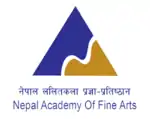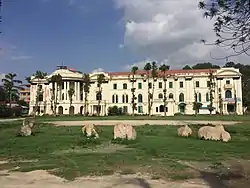Nepal Academy of Fine Arts
Nepal Academy of Fine Arts (NAFA) is the umbrella organization of Nepali artists, researchers and art critics, and an arts institution for research and for exhibitions.[1] A museum in Kathmandu, in a neoclassical building from the 1930s,[2] presents collections of both traditional and contemporary paintings and other works. It was formerly part of Nepal Academy.[1] The Nepal Academy of Fine Arts has also published a number of books about art and Nepali artists.[3]
नेपाल ललितकला प्रज्ञा–प्रतिष्ठान | |
 | |
 Sita Bhawan, Naxal serves as the headquarter of the organization | |
| Abbreviation | NAFA |
|---|---|
| Predecessor | Nepal Academy |
| Formation | April 13, 2010 |
| Founded at | Kathmandu |
| Headquarters | Sita Bhawan, Naxal |
| Location | |
| Coordinates | 27°42′48.8885″N 85°19′49.32480″E |
Official language | Nepali, and other Nepalese languages |
Founding Chancellor | Kiran Manandhar |
Current Chancellor | Kanchha Kumar Karmacharya |
Current Vice Chancellor | Gopal Chitrakar |
Parent organization | Ministry of Culture, Tourism and Civil Aviation (Nepal) |
| Website | Nepal Academy of Fine Arts |
History
It was established on 13 April 2010 (31 Chaitra 2066 BS) by legislative parliament of Nepal and the operations were started on 15 April 2010 (2 Baisakh 2067 BS). The academy is located in Sita Bhawan, a palace built by Bhim Shamsher Jang Bahadur Rana in 1928 for his wife, Her Highness Sri Sita Bada Maharani Deela Kumari Devi. Kiran Manandhar served as the founding Chancellor of the academy.[4]
Academic Council and Academic Assembly
NAFA has two constituent parts - Academic Council and Academic Assembly. The major function of the Academic Assembly is to make policies and programmes for the development of Nepali art. The major function of the Academic Council is to execute those policies and programmes in association with Nepali artists. The Academy Council also collaborates with other art organizations occasionally. The Academic Council consists of Chancellor, Vice-Chancellor, Member Secretary and the Members of Academic Council. Each cabinet serves for 5 years.
| Academic Council | |||
|---|---|---|---|
| Title | 2067-2070 (2010- 2014) | 2071-2075 (2014-2018) | Current Council |
| Chancellor | Kiran Manandhar | Ragini Upadhyaya | Kanchha Kumar Karmacharya |
| Vice-Chancellor | Thakur Prashad Mainali | Sharada Chitrakar | Gopal Chitrakar |
| Member- Secretary | K.K. Karmacharya | Nava Raj Bhatta | Bipin Kumar Ghimire |
| Academicians | Sharada Chitrakar | Naradmani Hartamchhali (Architecture and other Creative Art) | Ramesh Nath Khanal (Architecture and other Creative Art) |
| Karna Prasad Maske | Subodh Chandra Das (Folk Art) | Mithila Devi (Folk Art) | |
| Shanta Kumar Rai | Ramesh Shrestha (Painting) | Sushma Rajbhandari (Painting) | |
| Om Bahadur Katri | Dhana Bahadur Yakhkha (Sculpture) | Lal Kaji Lama (Sculpture) | |
| Rabin Kuman Koirala | Nima Ghyamchho Lama (Traditional Art) | Buddhi Bdr. Gurung (Traditional Art) | |
| Sushama Rajbhandari (Handicraft) | Dharma Raj Shakya (Handicraft) | ||
Departments
As of 2022, the departments in the academy are as follows:
- Traditional Art
- Sculpture
- Folk Art
- Painting
- Handicraft
- Architecture and other Creative Arts
Awards
The academy grants many awards and honours to various artists for their contribution to Nepali artform.[5] The awards given by the organization are:
- National Araniko Award (Rashtriya Araniko Samman)
- National Fine Arts Awards (Rashtriya Lalit Kala Puraskar)
- Traditional Painting
- Modern Painting
- Modern Sculpture
- Traditional sculpture
- Folk Art
- Handicraft
- Architecture and other Creative Arts
- Special Awards
- Traditional Painting
- Modern Painting
- Modern Sculpture
- Traditional sculpture
- Folk Art
- Handicraft
- Architecture and other Creative Arts
- Province-level Awards (An award from artist from each of the seven provinces)
- National Fine Arts Journalism Award (Lalit Kala Rashtriya Patrakarita Puraskar)
- National Fine Arts Writing Award (Lalit Kala Rashtriya Lekhan Puraskar)
The awards are presented annually. National Araniko Award is feliciated to two artists every years. The winners of the National Araniko Award are presented with a cash prize of रु100,000 and National Fine Arts Awards with रु60,000 for each category. Similarly, the Special and Province-level Awards carries a cash prize of रु25,000 for each category or province.[6]
References
- Khattri, Netra Bahadur. "The development of modern and contemporary art in Nepal". My Republica. Retrieved 22 June 2020.
- Nepal's national art collection at risk in building damaged by earthquake, The Guardian, 8 May 2015.
- http://nafanepal.org/publication/ retrieved August 8, 2020.
- "Kiran Manandhar: Artists are the heart of a country". kathmandupost.com. Retrieved 30 March 2022.
- "राष्ट्रिय अरनिको सम्मान–२०७७ तथा राष्ट्रिय ललितकला पुरस्कारको घोषणा". GorakhaPatra. Retrieved 1 April 2022.
- "राष्ट्रिय अरनिको प्रज्ञा–सम्मान र राष्ट्रिय ललितकला पुरस्कार घोषणा". नेपाली जनता :: Nepali Janta. 5 April 2021. Retrieved 1 April 2022.